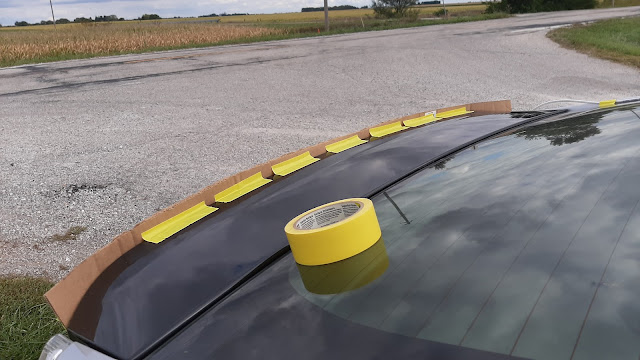Measuring Pressure Changes With a Spoiler: Part 3
This summer, I tested a large spoiler at different angles, with and without fins, by measuring pressures on the rear window and base of a Prius.
 |
| Measurement locations are the same as in the previous test. |
1) F = pA. In words, force is the product of pressure and area.
2) Pressure, p, always acts normal (i.e. perpendicular) to a surface.
3) Forces, pressures, and areas can be represented as vectors, which you can think of as imaginary “arrows” (that is, they have a magnitude [the arrow’s length] and a direction [where the arrow points]).
4) Vectors can be decomposed into components along each of the three dimensions.
…...where subscript “1” refers to the base and “2” to the
window, and phi is the average angle of the window from horizontal.
All right, now I’ve got everything I need to estimate the
changes from fitting each spoiler. Negative numbers represent an increase in
drag or higher lift, and positive numbers a decrease in drag or lower lift:
Aha! Now some trends become clear that weren’t before. As
the large spoiler’s angle increases, the increase in pressure may offset the
drag increase from the base to an inflection point (around 20°)
after which drag increases with spoiler angle. The small Gurney flap is
probably better than the 10° spoiler, in terms of its effect on
both lift and drag. And the slot doesn't appear to make a difference in the spoiler's effect on body panel pressures, although I don't know if it changes the force acting on the spoiler itself.
However, take all these with a healthy dose of skepticism. I
had to make a lot of simplifying assumptions, and I only did this so I could
compare the different spoilers and try to get an idea of which might be better
for my purposes in the future. There may be interactions between any one spoiler design and another part of the body I didn't measure. The pressure across the panels I did measure may vary considerably from the spots where I placed the taps. I’m not able to account for the drag or lift of
the spoilers themselves, and I haven’t verified any of these calculations by,
say, measuring lift directly.
That said, stay tuned because in the future I'll try and
measure changes in drag and lift directly. That should give me a good idea of whether this method
is useful or not by corroborating what I calculated here or throwing it all out
the window.
[*Note that I am using aeronautical convention, with positive
vertical axis pointing downward].
|
Spoiler Type |
Change in Drag
(N) |
Change in Lift
(N) |
|
Gurney flap (both) |
-7 |
+20 |
|
10°
spoiler |
-10 |
+10 |
|
20°
spoiler |
-5 |
+30 |
|
20° slotted spoiler |
-5 |
+30 |
|
30°
spoiler |
-20 |
+30 |











Comments
Post a Comment